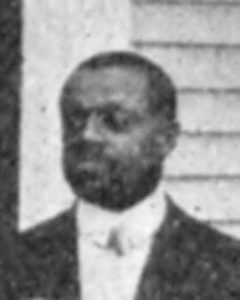
James Brister
*The birth of James Brister is celebrated on this date in 1858. He was a Black dentist.
Born in Philadelphia, he was the son of dentist Joseph Brister and Olivia Rebecca Parker Brister. The families came to Philadelphia from Delaware and Maryland. In 1860, Joseph Brister was already a member of the Banneker Institute, organized in 1854 by a group of men interested in literary pursuits and debating; a few years later, he was a member of the Social Civil and Statistical Association, organized in 1860 to focus on suffrage, financial conditions, and civil and social rights in Philadelphia's Black community.
In 1861, when he was just three years old, his father, Joseph, practiced dentistry at 606 Pine Street. During the 1870 census, the family lived at 818 ?? in Philadelphia's Seventh Ward. Three domestic servants, all forty-five-year-old Black women with different surnames, also lived in the house in 1870. By 1880, James, age 22 and now a Penn Dental School student, was listed as a dentist like his father; Olivia was a teacher; the two other children in the household were still very young, Theophilus, age seven, and Angela, age two.
Brister had entered Penn's Dental School in 1879. He presented his essay on "The Dental Tissues" in February of 1881, and on March 15 of that year, he was listed as one of the founders of the Society of Alumni of the Dental School. Sometime in the early 1880s, James Brister's mother died. About 1885, his father Joseph remarried; he and his second wife, Lucy Warfield, had four children. According to the Philadelphia City Directory, father and son practiced dentistry together at 844 Lombard Street in 1890. But shortly after that, the younger Brister moved to Chicago and would spend the rest of his life in Illinois.
The first issue of Polk's Dental Directory, from 1893, listed Brister's Chicago dental office at 2970 Dearborn Street. He practiced dentistry on State Street from 1898 to 1901 and then on Michigan Avenue in 1902 and 1903. From 1908 through 1915, he was listed as practicing in Zion, a small city on Lake Michigan just below the Wisconsin border. Zion was founded in 1901 by John Alexander Dowie, founder of the Christian Catholic Apostolic Church and leader of the Divine Healing Association.
Brister had joined Dowie's tabernacle in Chicago and became one of the earliest residents of Zion, the only dentist, and one of only four Black families. According to a 1904 publication, James Brister was a deacon in Dowie's church, and his wife, Anna D. Murrell Brister, was a deaconess. James and Anna had two sons and daughters, all born in Zion between 1901 and 1906. The family lived first at 1902 Ezekiel Avenue and then at 3102 Enoch Street; Brister's dental practice was conducted in "Temple Cottage," a wooden farmhouse on Sheridan Road. That James Brister was well-respected in Zion is further shown by the fact that he was a city alderman and the only Black city official.
He was also reportedly the only city resident who could play Zion's huge pipe organ, the biggest in the world. James Brister died in 1916, leaving his wife to raise their adolescent children. By the mid-nineteenth century, Anna and both her daughters plus a daughter-in-law had severe mental problems.